Mine came without caps. There were a few scratches, but the soft front coating was mostly intact. Most important, there was no visible haze when I blasted a flashlight through it. Buzz at home – vintage 90mm f/2 Summicron v2 (1959) Old lenses are cheap. You can get that old 50mm Elmar or Summitar, adapter and a crop-sensor mirrorless camera for under $750. A previous-generation full-frame mirrorless camera raises the total to just under $1000. But if you already have a camera, the lens by itself will run you just $320 or so for an optically clean copy with a few scratches on the metal. A vintage 35mm lens will be a bit more – maybe $600 or so for a 35mm f/3.5 Summaron with clean glass. And a vintage 90mm f/2 Summicron from 1959 will run $500 to $900 or so with good glass. Why Use Vintage Lenses? Why would you want a 60+ year-old 50mm (or 35mm or 90mm) lens instead of a new kit zoom? One-word answer – character. 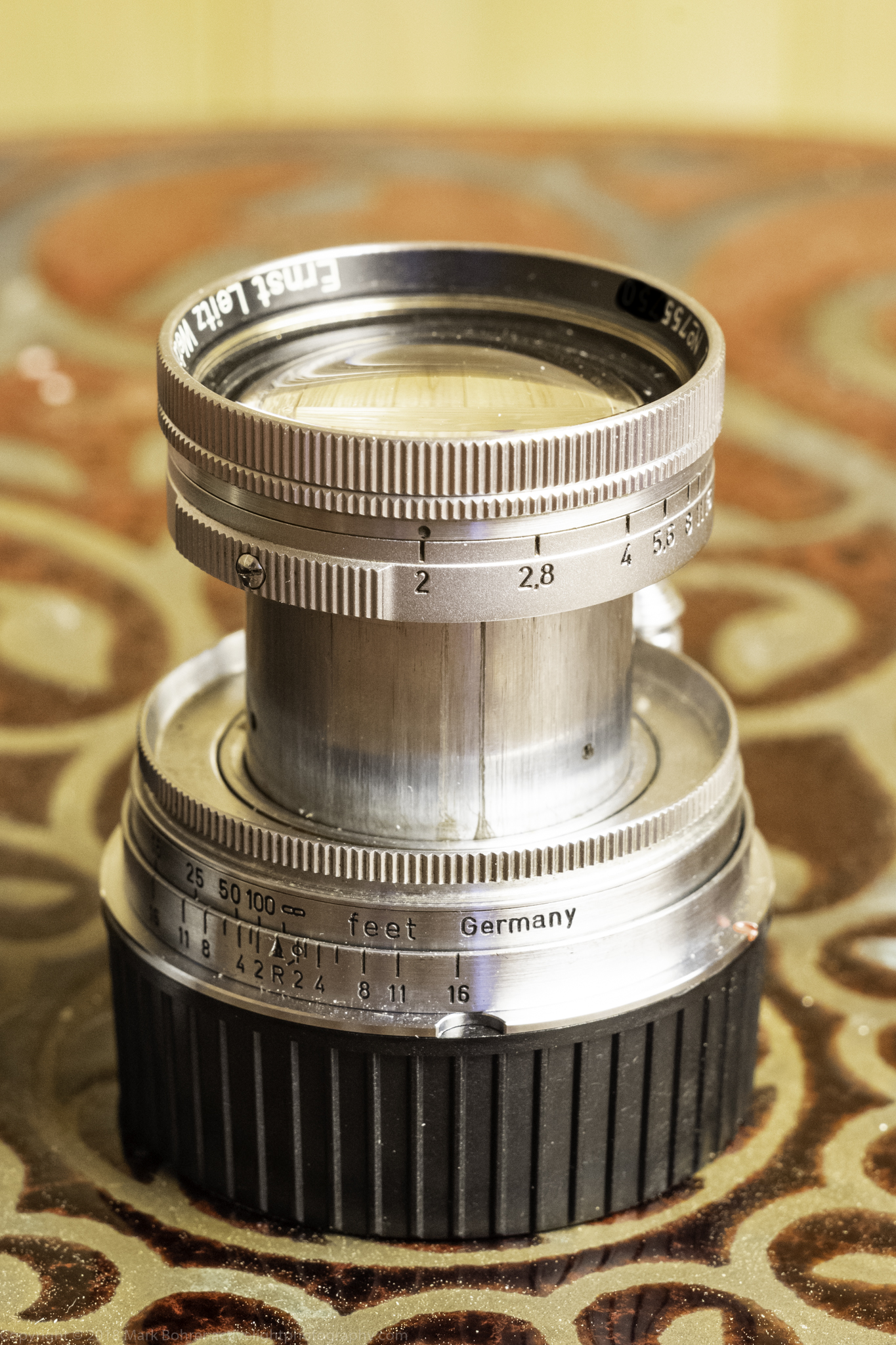 50mm f/2 Summitar from 1949 – dusty optics and scratches on the barrel, but a vintage bargain Leica lenses like the 50mm f/2 Summitar and its Summicron descendants have always had some of the highest resolutions in the world for their time. But older lenses are less sharp at maximum aperture than their modern equivalents. The effect is sometimes described as luminous glow, the effect of less-than-perfect optical correction. Designed Without Computers = Glow 60+ year-old vintage lenses were designed in a time without computers. They also used elements with spherical surfaces, ground to a circular shape. These two things usually mean that not all the colors starting at the same point in your scene end up at a single point on your sensor. Or the lens may direct light rays to slightly wrong places on the sensor. Either way, you get a slight smearing from the imperfectly-corrected lens. Lens designers call these imperfections spherical aberration. Today designers use aspherical elements to minimize it. Aspherical elements aren’t perfectly spherical – their cross-sections look like a handlebar mustache. They help focus all the light rays where they belong. Glow can also be the effect of less-than-perfect (or complete lack of) optical coatings on lens surfaces. Modern lens coatings were invented by Zeiss in Germany in 1935, and were a closely-held German military secret until the early 1940s. Coatings reduce the internal reflections and scattering at glass surfaces, giving a brighter, sharper image. Stop Down for Sharpness? One way to improve sharpness with older lenses is to use a smaller aperture. Stopping down to f/5.6 or f/8 adds sharpness and extends its range out towards the corners. It’s a bit like having two lenses in one – you get the glowy rendering (and shallow depth of field) at maximum aperture, and better sharpness stopped down. Stopping down blocks light from a lens’ outer edges. The remaining central light rays are much less likely to spread away from the points they’re supposed to hit, depending on the lens design. Less spreading appears as more sharpness. However, sometimes stopping down a lens changes its best focus point. A lens may focus to a sharp point at its maximum aperture, usually the one cameras use before you take the picture. If you’re using a manual lens, you’ll do this by hand – focus at maximum aperture for best precision, then stop down to the required aperture. But when the lens stops down to the aperture you or the camera chose for the actual exposure, the remaining light rays may converge at a point different from the best focus point for all of them at maximum aperture. The only way to tell if this is happening is to test a lens at different apertures and a single point of focus. Older lenses are more prone to it, but 50mm and shorter (wider-angle) lenses tend to mask the effect with depth of field at smaller apertures. Because they send most of the outer light rays to the correct places, aspherical lenses are less likely to have focus shift. 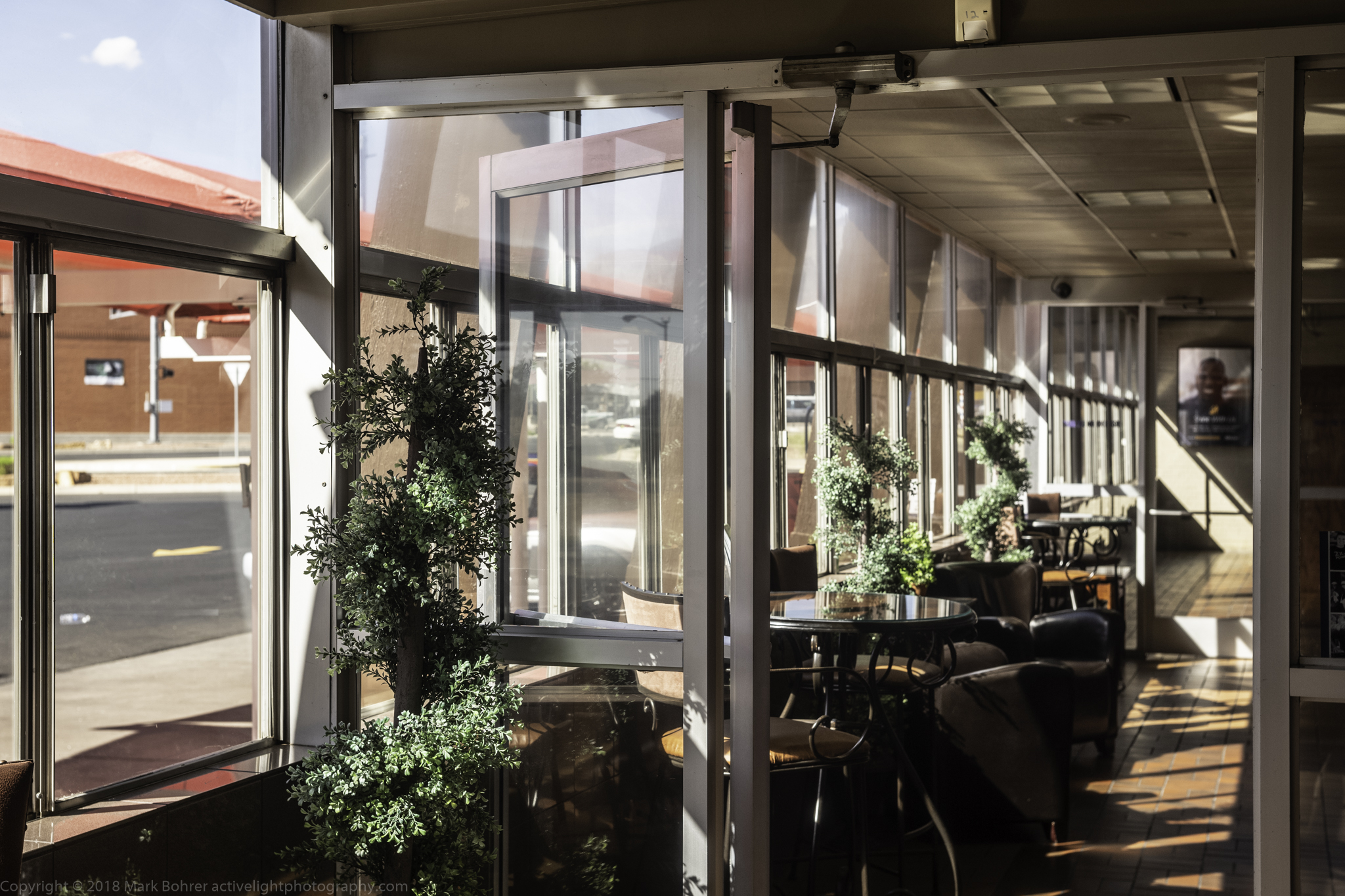 To the vanishing point at the car wash – 50mm f/2 Summitar (1949) Test It At the Car Wash, Yeah So I found myself at the carwash and later at one of my favorite restaurants with this almost 70-year-old Summitar lens. I’d already tried a few shots with my mirrorless Leica SL, and discovered it worked fine, though it was a little hard to focus precisely at f/2. When a subject’s edges glow from aberration, it’s hard to find the sharpest focus through the lens. Of course, that’s some of the charm. Don’t Look Through It – Rangefinder Focusing Instead, I had the Summitar mounted on my rangefinder-focusing Leica M10. All Leica film cameras have used so-called coincident rangefinder focusing since 1932. M-series digital Leicas focus this way too. As you turn the focusing ring, a helicoid screws in or out of the lens and pushes a cam in the camera body. This cam turns a prism that bends the light entering a small window. A fixed prism behind a second large window receives the light from the moving prism along with light in front of it, and the combined light reaches your eye through the viewfinder. The two beams of light will only coincide at one angle of the moving prism. Camera and lens calibration ensures the twin images become one only when the lens is focused. Those twin images only appear in a small patch in the center of modern M-cameras, so you can choose the sharp point in pictures. None of this depends on looking through the lens. With correct calibration, you’ll focus at the point you choose regardless of lens aberrations, as well as the lens can focus. If there’s focus shift, you may still miss the focus point. But since depth of field is wider at smaller apertures, you may not see it. 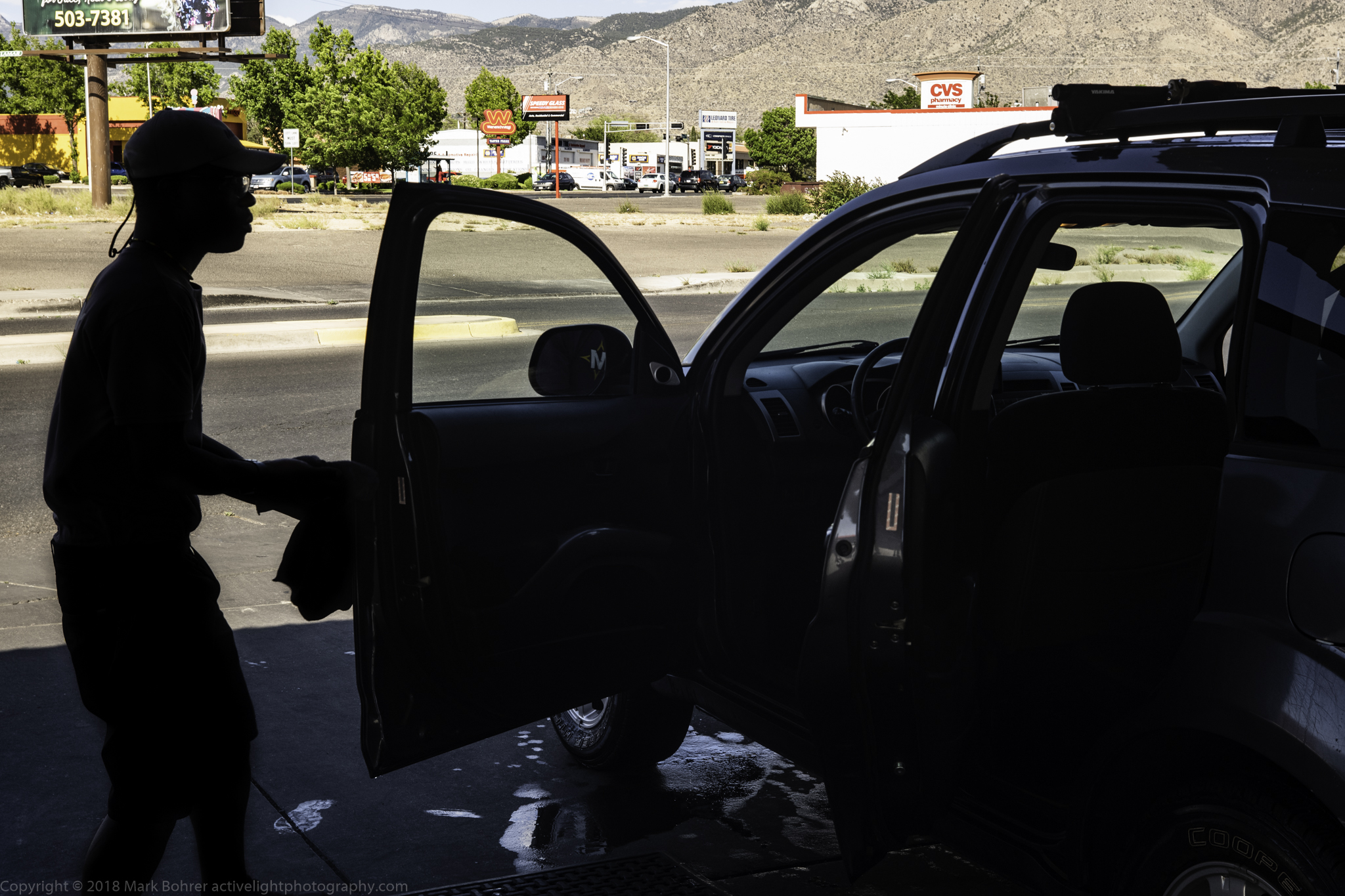 Finish the wash – 50mm f/2 Summitar (1949) To The Vanishing Point I stopped the Summitar down to f/4 for a little depth of field, and went looking for pictures. I’ve always liked so-called vanishing point shots, where prominent lines converge to a distant point. I’d already noticed these in the waiting area at my local car wash, and I had a filthy car. I didn’t shoot straight down the throat – I liked the angled view. As they were putting the finishing touches on my wash, I visualized and shot a silhouette of one of the workers against my little corner of Albuquerque. To their credit, none of the workers paid me any attention. I was just some guy with a camera, and they had work to do. 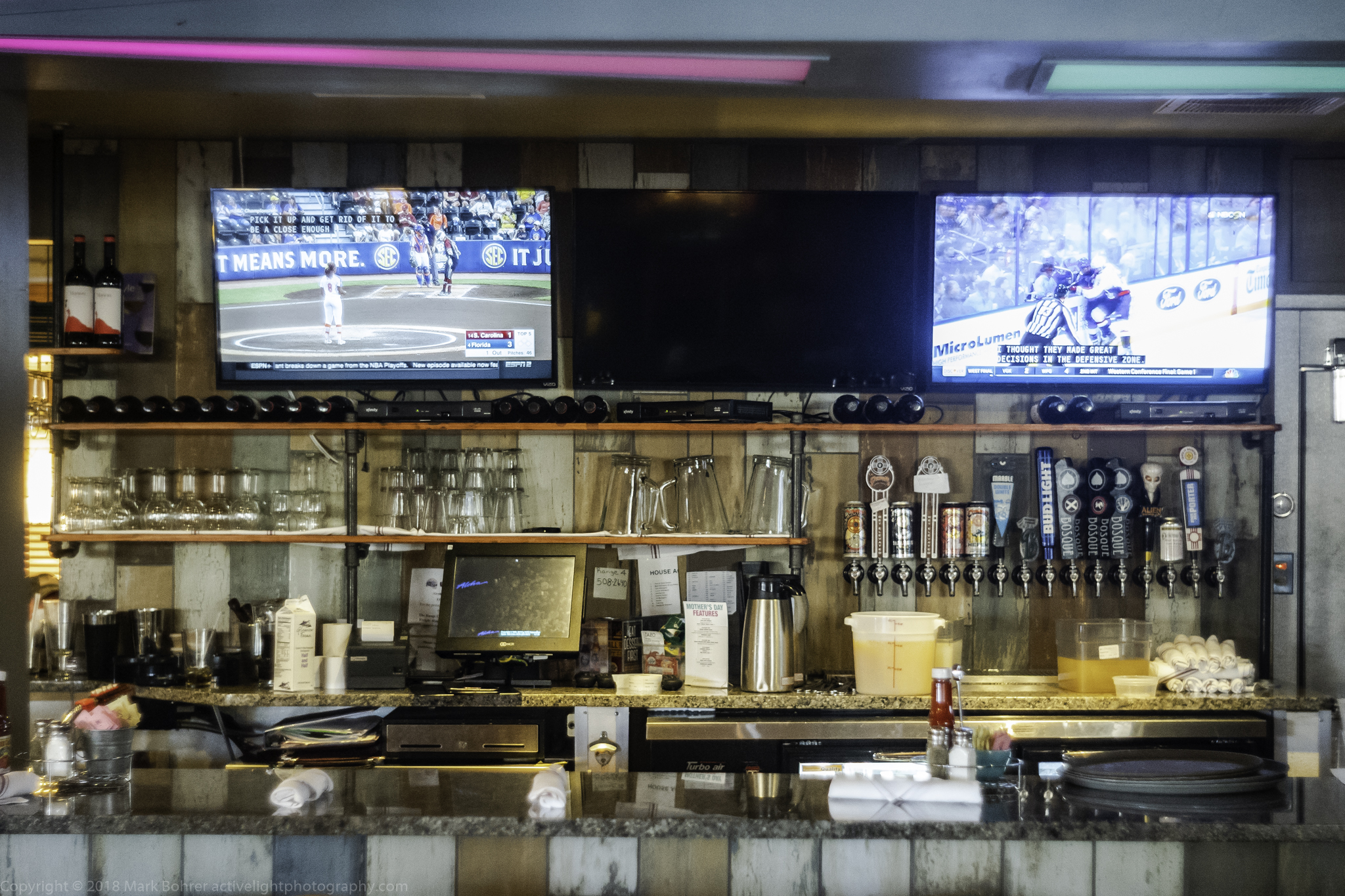 Bar at the Range – 50mm f/2 Summitar I was hungry (it was dinner time after all), so I decided to go to O’Neil’s Pub and sit outside. But the place was packed, and I didn’t want to wait for a table, so off I went to local favorite The Range Cafe. I usually carry at least one lens with a 19″ minimum focus distance for food shots. But I didn’t have it this time, and the Summitar’s closest focus is one meter, about 39″. A rangefinder’s combination mechanical / optical design limits how close you can go. For early Leicas, the limit was 1 meter. So I took a straight-on bar shot at maximum aperture, f/2, focusing on some beer taps. The picture shows a noticeable difference between sharpness in the beer taps away from light sources on the right, and the glassware closer to window light on the left. Everything looks generally glowy, for a somewhat nostalgic rendering of the bar. Bootleg liquor, anyone? 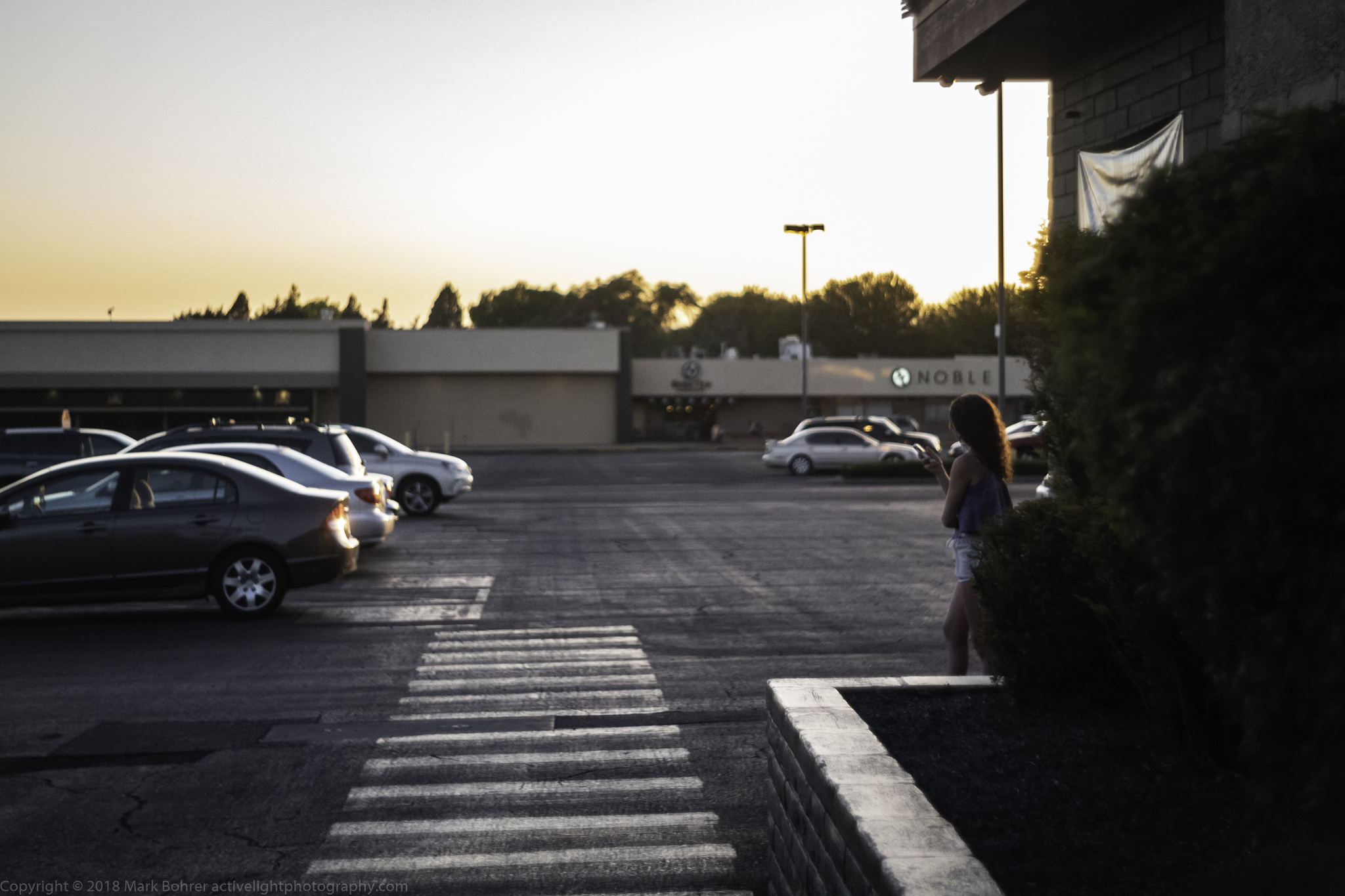 Waiting for a ride – 50mm f/2 Summitar Outside after my meal, I noticed a young woman waiting for her ride home. She was backlit by reflected sunlight, and the sun’s big ball was already below the trees. This kept flare from wiping out the picture, though high-contrast edges showed some of it. The wall at upper right has a double edge from flare. Lens flare is a defect in older lenses (and some newer ones), caused by internal reflections from strong light sources in the picture or just outside it. Effective lens coatings and a lens’ interior baffling can reduce or eliminate it. 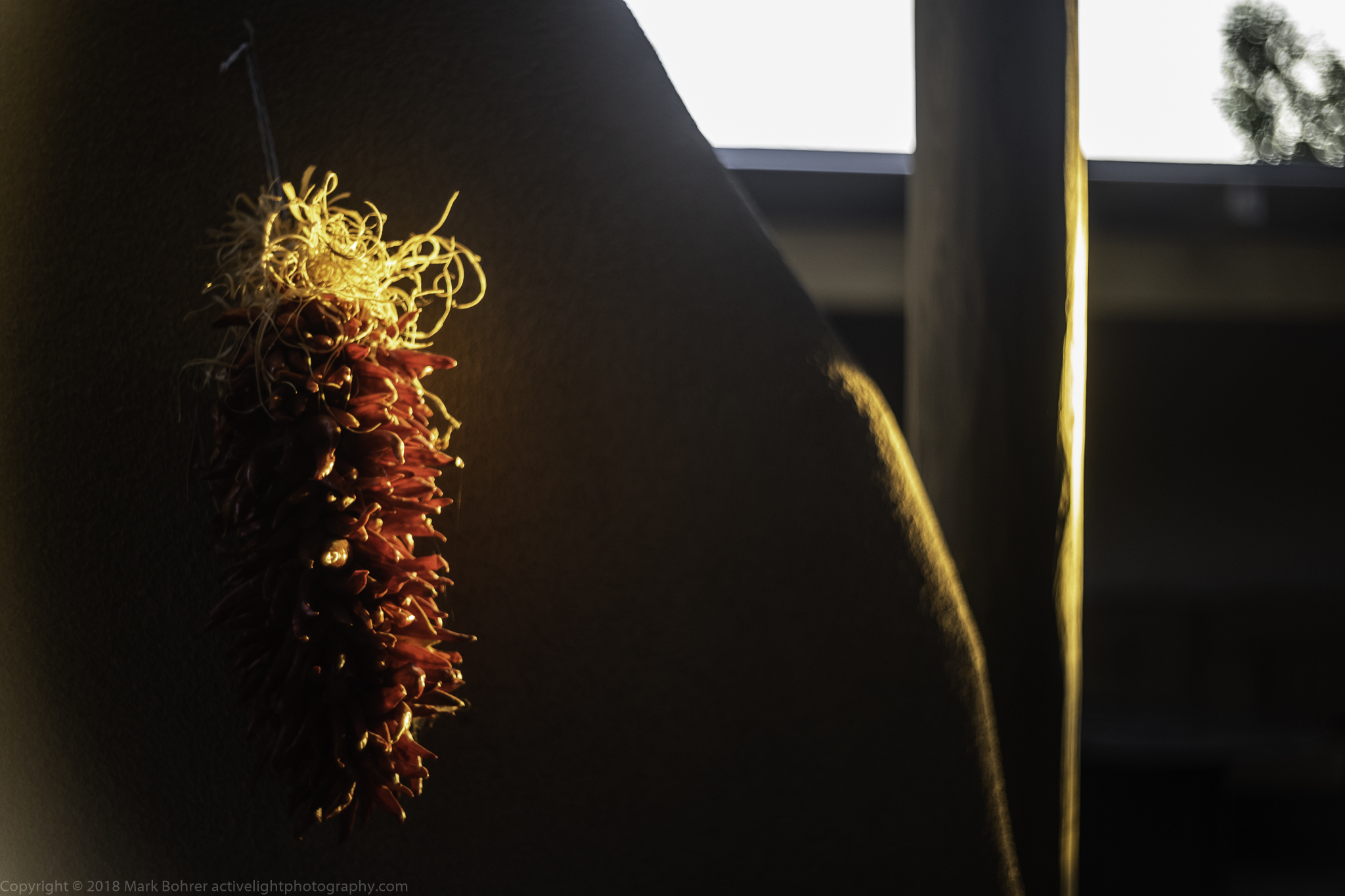 Ristras – veiling flare at left from 50mm f/2 Summitar at f/2 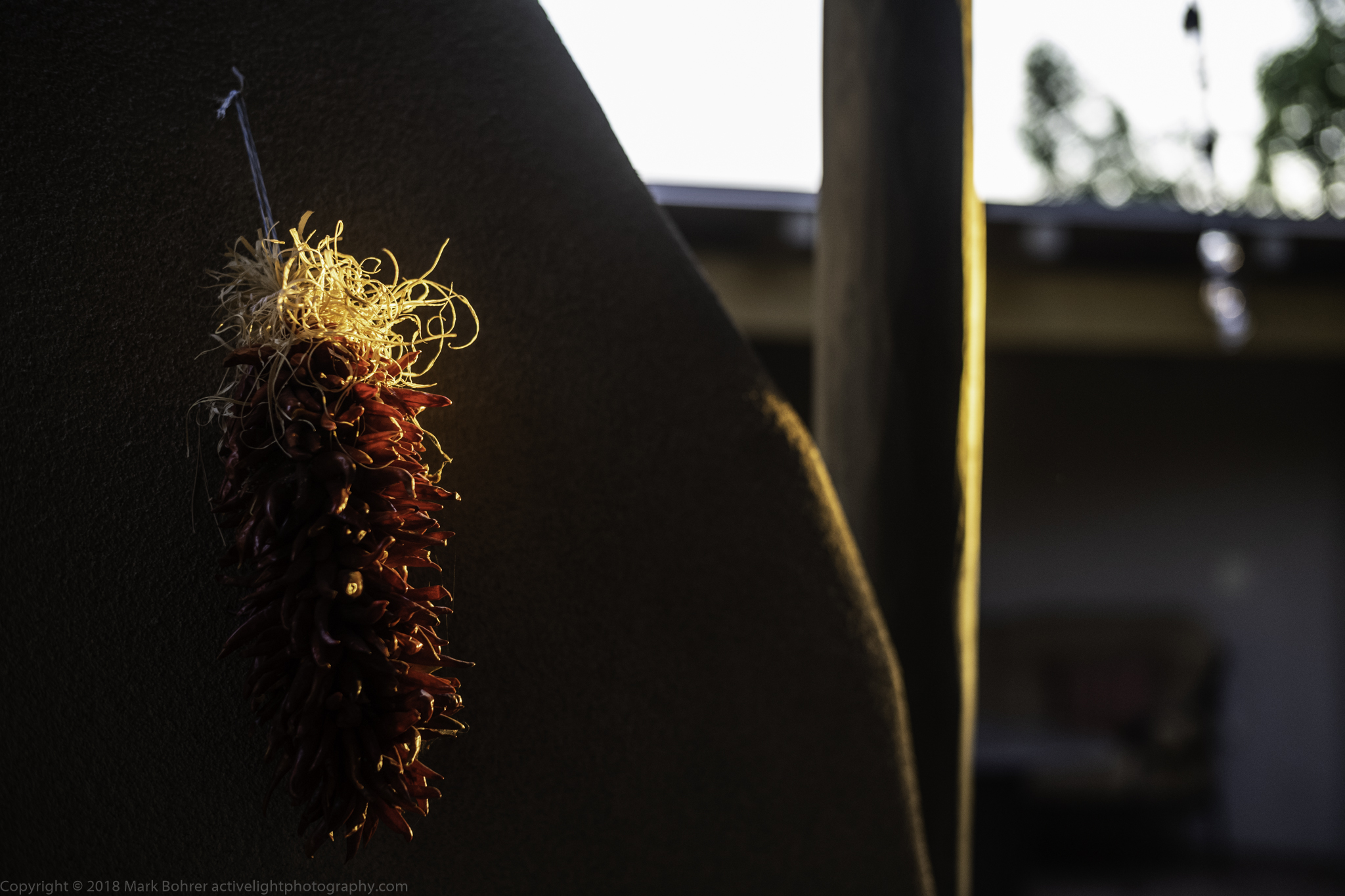 Ristras – no flare from 50mm f/1.4 Summilux-M ASPH at f/2 Nearby Sun = Veiling Flare The Summitar will give you strong veiling flare at its f/2 maximum aperture. I noticed strong sidelight on a ristra near sunset, and went out to shoot it. The sun was blocked by a wall, but the light was too strong anyway. I ended up with a hazed-out arc on the edge opposite the sun. I’d never seen this before with any lens. I took the same shot a few minutes later with a 50mm f/1.4 Summilux-M ASPH (a lens with aspherical surfaces) just to be sure nothing about the picture was causing it. But nope, it was definitely the Summitar. 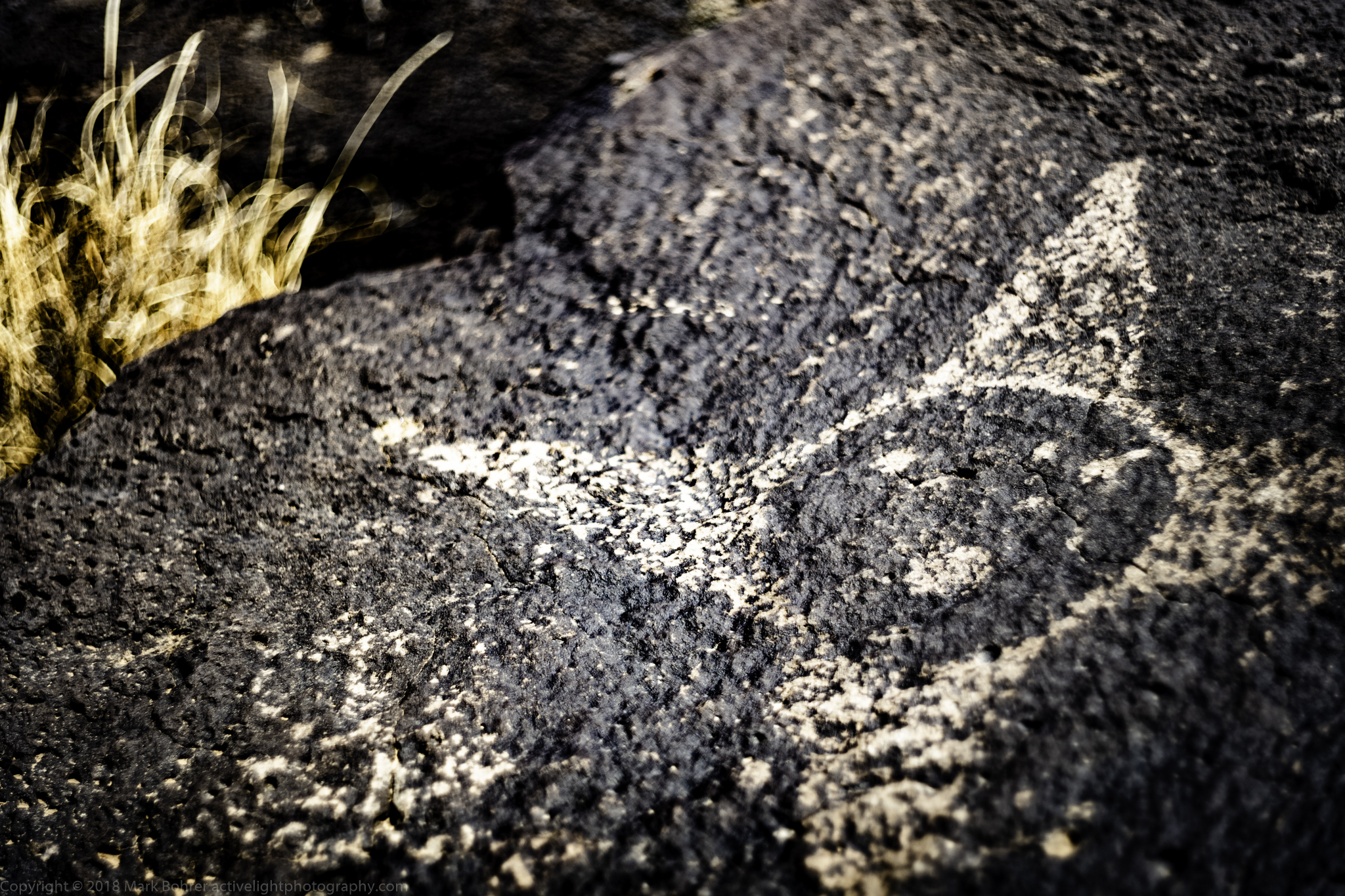 Star Kachina – 50mm f/2 Summitar at f/2, 1m distance – contrast enhancement in Lightroom The Summitar gave a liquid, swirly look to 700 year-old petroglyphs. I’d last been to Petroglyph National Monument’s Piedras Marcadas Canyon with 14mm and 35mm lenses and their wide fields of view. The Summitar’s narrow depth of field at f/2 and focused view gave me thin pieces to suggest a larger panel. 90mm Improvements My Berner Daisy had been sedentary following a cancer treatment. She was feeling better a few days later, so I mounted a 90mm f/2 Summicron lens from 1959 on the M10, and away we went.  Playing on the dam – 90mm f/2 Summicron v2 (1959) Young kids were letting a skateboard loose and chasing it down the incline of a shallow dam at my local park. I didn’t need to ask them to keep doing it as I walked closer for better pictures. Their dad was capturing the action with a cell phone, and no one seemed to mind my presence. I’d known I’d need a narrower angle of view near mid-day to minimize the contrast range – a smaller scene presents less contrast than a broad landscape – and that was why I chose the 90mm f/2 Summicron from 1959. It was one of the first computer-designed lenses, and was so good they kept making them for another 21 years. Shot Notes If you can afford it, multiple lenses give you different ‘brushes’ for rendering pictures. I’ve somehow ended up with four different 50mm lenses designed over a 53 year period. They all ‘draw’ a picture differently. The most recent 50mm f/1.4 Summilux-M ASPH focuses down to 70cm, about 27.5 inches, and mostly ignores strong light sources in the picture. I actually bought it after shooting a party where the previous-generation 50mm f/1.4 Summilux caused uncorrectable heavy flare in a critical shot. The ASPH lens gives a very sharp rendering that may not be to everyone’s liking, especially for some portraits. Then there’s the lens I grew up with, a 1954-era 50mm f/1.5 Summarit my grandfather bought before I was born. 1950s-era Leica lenses had very soft coatings, so my zealous teenaged self scratched the heck out of it keeping the front element clean. I didn’t want to sell it – wasn’t worth much anyway – so I had it cleaned and re-coated. It’s very soft at f/1.5, making it a good choice for some portraits. 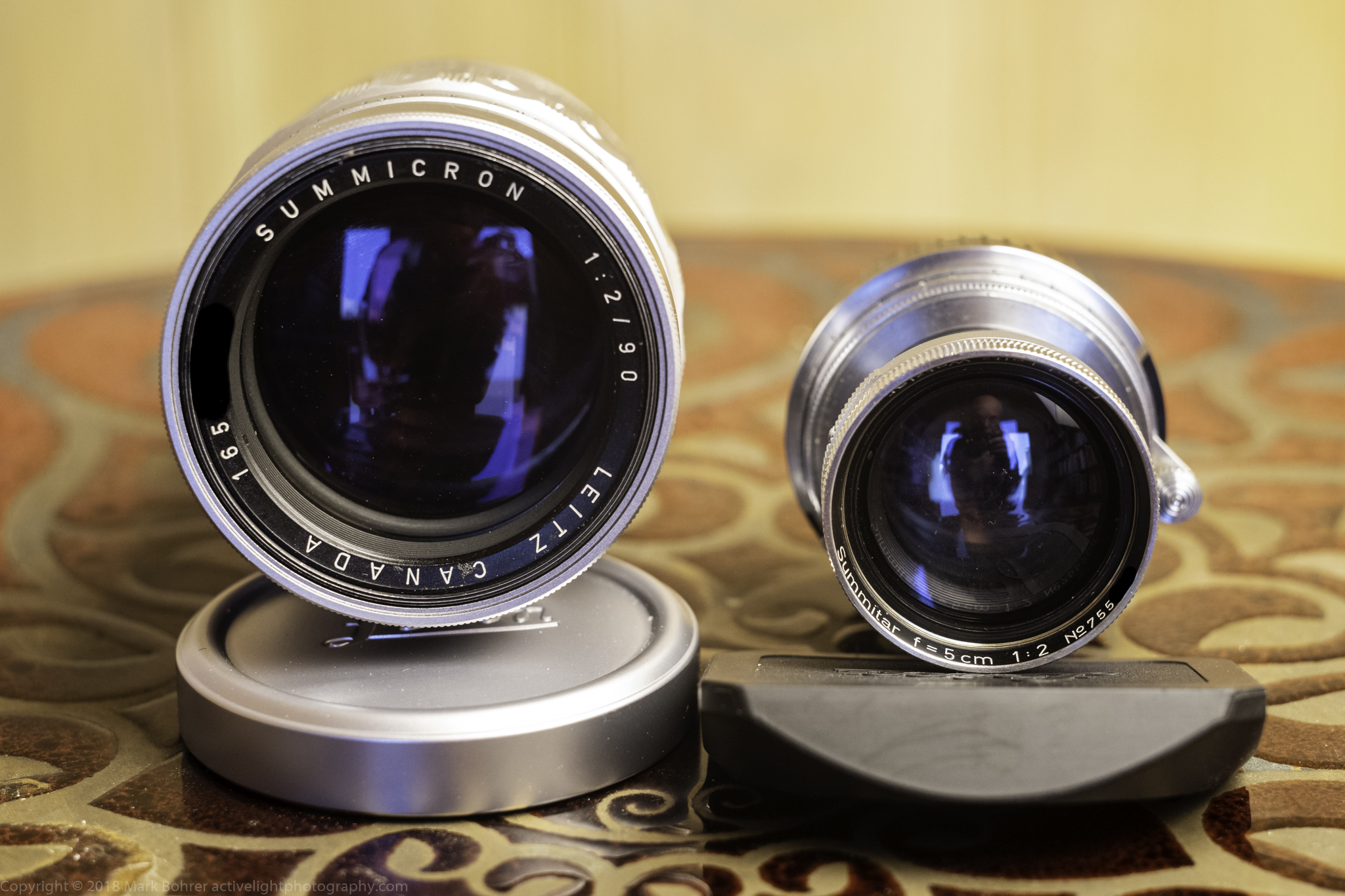 90mm f/2 Summicron v2 (1959, L) and 50mm f/2 Summitar (1949) I bought the tiny 50mm Summitar for its legendary glowy rendering, after some research and searching for one that was cheap but optically unfogged, unhazed and unscratched. I also picked up a cheap knock-off of Leica’s SNHOO filter adapter. Since the lens’ native filter thread is a hard-to-find 36mm, this lets me attach a protective 39mm filter over this soft-coated lens. I screw a cheap vented lens hood into the filter to minimize flare – as much as I can anyway. So far, the Summitar has lived up to its glowy reputation, and it’s sharper than I expected stopped down a bit. More Information Mansurov, N. (February 12, 2018) What is Spherical Aberration? Retrieved from https://photographylife.com/what-is-spherical-aberration Mansurov, N. (February 12, 2018) What is Focus Shift? Retrieved from https://photographylife.com/what-is-focus-shift Mandler, W. (1989) Leica Lenses and Eartly Computers. Retrieved from https://tinyurl.com/y8hljqkk Rockwell, K. (2011) Leica 50mm f/2 Summitar (1939-1953). Retrieved from https://kenrockwell.com/leica/50mm-f2-summitar.htm Rockwell, K. (2011) Leica 90mm f/2 Summicron (Canada, 1959-1980). Retrieved from https://kenrockwell.com/leica/90mm-f2.htm Taylor, J. (2 years ago) A Primer on Rangefinder Cameras. Retrieved from https://tinyurl.com/ya54eeh3 Wikipedia (n.d.) Anti-reflective coating. Retrieved from https://en.wikipedia.org/wiki/Anti-reflective_coating |
(408) 483-3782
Curious about how to shoot ruins?(408) 483-3782

Recent Comments